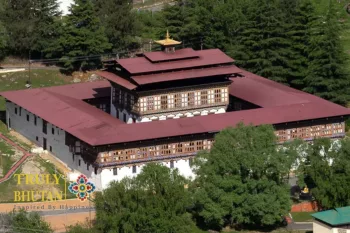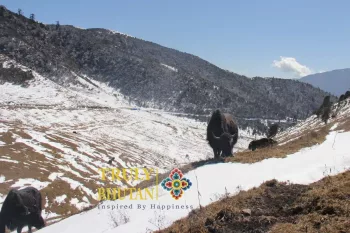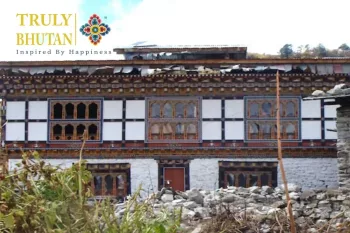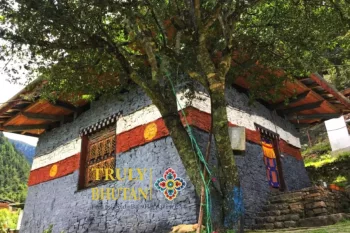The magnificent Lhakhang Karpo was established in the 7th century by Tibetan king Songtsen Gampo in his mission to build 108 monasteries in one day and subdue the evil demon. He built Lhakhang Karpo and Lhakhang Nagpo in the Haa Valley. According to a legend, a black and white pigeon was released to select sites to build the temples.
These two temples stand as the guardian sentinels keeping watch at the south entrance of the valley. The Lhakhang derived its name from the white pigeon that landed on the foothills of the three towering mountains worshipped as Rigsum Gonpo and is where the Lhakhang stands today.
History of Lhakhang Karpo, the Premier Temple of Haa Valley
Lhakhang Karpo is one of Bhutan’s oldest and most revered temples. Its construction is traditionally credited to the 7th century, making it a place of historical significance. Although the present-day structure dates back to a more recent period, it remains an imposing edifice built on a vast scale. The temple is named “White Temple” or Lhakhang Karpo, in contrast to its adjacent smaller counterpart, Lhakhang Nagpo or “Black Temple.” Let’s explore the fascinating history, legends, and renovation of Lhakhang Karpo.
Lhakhang Karpo’s backstory is entwined with several legends, and one of the most popular traces their construction to Songtsen Gampo, the first Buddhist king of the Tibetan Empire. According to the legend, Songtsen Gampo released a pair of black and white pigeons from Lhasa that flew 320 kilometers and descended on the Haa Valley. Temples were then erected on the respective locations in a single day. Another legend replaces the pigeons with rays of sunlight that emanated from Songtsen Gampo himself. The two temples were constructed at the spots where the rays shone upon the ground in the Haa Valley.
Ap Chungdu & the Mythical Origins of Lhakhang Karpo
A third legend attributes the construction of Lhakhang Karpo and Lhakhang Nagpo to a group of mysterious, supernatural laborers who appeared from the hills of Haa and worked for a day to build the temples before vanishing back into the mountainside. In the Haa region, these esoteric laborers are linked to the hills, which are widely believed to be the abode of Ap Chungdu, the protective deity of the valley. Although it’s unclear if Ap Chungdu sent the laborers, his role in the valley’s history and as a protective deity is worth noting.
The central figure of worship within the main Lhakhang is a statue of the Amitabha Buddha (Sangye Tshepamey). According to Tshering Tashi’s writing in the Kuensel Online, the statue’s head is slightly bent and somewhat disproportionately large for the body, a unique feature. Interestingly, the statue’s sculptor was having trouble creating the statue’s head. As the sculptor grew frustrated, a stranger arrived early in the morning with a completed head and then disappeared. The inference is that this mysterious benefactor was none other than the protector deity Ap Chungdu.
The King's Initiative to Renovate Iconic Lhakhang Karpo Temple
By the late 2000s, the Lhakhang Karpo temple and surrounding buildings were in a state of disrepair. After visiting the temple in November 2009, His Majesty The King ordered its restoration, costing several million USD or Nu 149M, including the construction of several drashags (monks’ quarters) and other amenities for the roughly 100 resident monks. The temple was formally re-consecrated on June 16th, 2018. Today, visitors can witness the grandeur of Lhakhang Karpo, home to the District Monastic Body of Haa.
The primary buildings of Lhakhang Karpo are constructed in a “C” shape around the central Lhakhang, the temple’s heart. In front of these buildings, facing east, is a spacious courtyard overlooking the Haa Valley’s eastern side. A statue of a white horse stands at the square’s east end, symbolizing Ap Chungdu’s mount. Visitors can take a tour of the temple and witness the intricate details and artwork inside. The interior of the temple is adorned with murals and frescoes that depict various scenes from Buddhist mythology and history.
Legends & Myths Surrounding Lhakhang Karpo in the Haa Valley
The legends and myths surrounding Lhakhang Karpo offer a fascinating glimpse into the cultural and religious history of Bhutan. The temple’s construction and Ap Chungdu’s role as a protective deity are intertwined with the region’s landscape, history, and belief systems. Exploring the legends and myths surrounding Lhakhang Karpo can provide a deeper understanding of Bhutan’s spiritual heritage.
The Haa Valley, where Lhakhang Karpo is situated, is known for its stunning natural beauty, pristine landscapes, and tranquil atmosphere. The temple offers a spiritual haven where visitors can immerse themselves in Bhutan’s rich cultural and religious traditions. The temple’s renovation and preservation ensure that it remains a place of worship, history, and culture for future generations. Lhakhang Karpo is a must-visit destination for anyone seeking to explore Bhutan’s spiritual and cultural heritage.
FAQs on Lhakhang Karpo
Lhakhang Karpo was established in the 7th century by Tibetan king Songtsen Gampo in his mission to build 108 monasteries in one day and subdue the evil demon. The temple is named “White Temple” or Lhakhang Karpo, in contrast to its adjacent smaller counterpart, Lhakhang Nagpo or “Black Temple.”
According to a popular legend, Songtsen Gampo released a pair of black and white pigeons from Lhasa that flew 320 kilometers and descended on the Haa Valley. Temples were then erected on the respective locations in a single day. Another legend replaces the pigeons with rays of sunlight that emanated from Songtsen Gampo himself.
The central figure of worship within the main Lhakhang is a statue of the Amitabha Buddha (Sangye Tshepamey).
By the late 2000s, the Lhakhang Karpo temple and surrounding buildings were in a state of disrepair. After visiting the temple in November 2009, His Majesty The King ordered its restoration, costing several million USD or Nu 149M, including the construction of several drashags (monks’ quarters) and other amenities for the roughly 100 resident monks.
Visitors can take a tour of the temple and witness the intricate details and artwork inside. The interior of the temple is adorned with murals and frescoes that depict various scenes from Buddhist mythology and history. In front of the primary buildings, facing east, is a spacious courtyard overlooking the Haa Valley’s eastern side. A statue of a white horse stands at the square’s east end, symbolizing Ap Chungdu’s mount.





